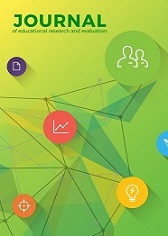Analysis of Mathematical Connection and Students' Self Confidence in Flat-Side Space Material
DOI:
https://doi.org/10.23887/jere.v2i3.13007Keywords:
The ability of a mathematical connection, Self ConfidenceAbstract
This research is a study to analyze the ability of mathematical connections and self-confidence in the flat-side space material for junior high school students. This research used a qualitative descriptive method. The study was conducted at 47 Bandug Junior High School in 9th grade students of SMPN 47 Bandung who had studied in a flat side room. The research subjects were ninth grade F. The data were collected in the form of a description of the test instrument and self-confidence questionnaire. The results of the study concluded: 1) the level of students' mathematical connection skills in the settlement pointed at good categories; 2) students have mastered the materials so that they could understand problems and concepts well; 3) students already have had good self-confidence.
References
Ajay, K., (2016), Effect of Student Teams Achievemnt Division (STAD) method on problem solving ability in relation to Critical Thinking, International Journal Of Advanced Research and Development, Vol. 1, Page No. 26-30
Aripin, U.,& Purwasih, R. (2017). Penerapan Pembelajaran Berbasis Alternative Solutions Worksheet Untuk Meningkatkan Kemampuan Berpikir Kreatif. AKSIOMA: Jurnal Program Studi Pendidikan Matematika, 6(2), 225-233.
Depdiknas (2006). Kurikulum Tingkat Satuan Pendidikan. Jakarta: Depdiknas.
Fitriani, F.(2015). Hubungan Antara Kemampuan Pemecahan Masalah Matematis Denganself Confidencesiswa Smp Yangmenggunakan Pendekatan Pendidikan Matematikarealistik. Jurnal Euclid, 2(2), 341-351.
Giarti, Sri. 2014. Peningkatan Keterampilan Proses Pemecahan Masalah dan Hasil Belajar Matematika Menggunakan Model PBL Terintegrasi Penilaian Autentik pada Siswa Kelas VI SDN 2 Bengle Wonosegoro. Scholaria. 4 (3), 13-27.
Hendriana, H,. Rohaeti, E E,. & Sumarmo, U,. (2017). Hard Skill Soft Skill Matematik Siswa. Bandung; Refika Aditama.
Muhsetyo Gatot, dkk. 2009. Pembelajaran Matematika SD. Jakarta: Universitas Terbuka.
Maarif, H., & Wahyudi, W. (2015). Eksperimentasi Problem Based Learning dan CIRC dalam Menyelesaikan Soal Cerita Matematika Siswa Kelas 5 SD. Scholaria: Jurnal Pendidikan dan Kebudayaan, 5(2), 97-115.
NCTM (2000). Principle and Standards for School Mathematics. Reston, VA: NCTM.
Purwasih, R. (2015). Peningkatan Kemampuan Pemahaman Matematis dan Self Confidence Siswa MTS di Kota Cimahi Melalui Model Pembelajaran Inkuiri Terbimbing. Didaktik, 9(1),16-25.
Pujiono, R. (2017). Penerapan Model Pembelajaran Kooperatif Tipe Student Team Achievement Divisions (STAD) Untuk Meningkatkan Motivasi Dan Hasil Belajar Ipa Siswa Kelas V B SDN 047 Tarakan. Journal of Education Research and Evaluation. 1 (4), 198-203.
Rattanatumma, T., (2016), Assessing the Effectiveness of STAD Model and Problem Based Learning in Mathematics Learning Achievement and Problem Solving Ability, Journal of Education and Practice, Vol. 7, No. 12
Setiawan, A. 2009. Inplementasi Model Pembelajaran Conceptual Understanding Procedures (CUPs) sebagai Upaya untuk Meningkatkan Kemampuan Koneksi Matematika siswa. Skripsi Jurusan Pendidikan Matematika FPMIPA UPI : Tidak Diterbitkan.
Siswanto, R., (2014), Peningkatan Kemampuan Penalaran Dan Koneksi Matematis Melalui Penerapan Model Pembelajaran Kooperatif Tipe STAD Berbantuan Geogebra (Studi Eksperimen Di SMAN 1 Cikulur Kabupaten Lebak Provinsi Banten), Jurnal Pendidikan dan Keguruan, vol 1, No.1
Supraptinah, U., Budiyono, B., & Subanti, S. (2015). Eksperimentasi Model Pembelajaran Discovery Learning, Problem Based Learning, Dan Think-Talk-Write Dengan Pendekatan Saintifik Terhadap Kemampuan Pemecahan Masalah Matematika Ditinjau Dari Kemandirian Belajar Siswa. Jurnal Pembelajaran Matematika, 3(10).
Uno,H. 2007. Model Pembelajaran Menciptakan Proses Belajar Mengajar Yang Kreatif Dan Efektif. Jakarta: Bumi Aksara.
Wahyudi, W., & Siswanti, M. C. (2015). Pengaruh Pendekatan Saintifik Melalui Model Discovery Learning dengan Permainan Terhadap Hasil Belajar Matematika Siswa Kelas 5 SD. Scholaria: Jurnal Pendidikan dan Kebudayaan, 5(3), 23
Downloads
Published
How to Cite
Issue
Section
License
Authors who publish with the Journal of Evaluation and Research in Education (JERE) agree to the following terms:
- Authors retain copyright and grant the journal the right of first publication with the work simultaneously licensed under a Creative Commons Attribution License (CC BY-SA 4.0) that allows others to share the work with an acknowledgment of the work's authorship and initial publication in this journal.
- Authors are able to enter into separate, additional contractual arrangements for the non-exclusive distribution of the journal's published version of the work (e.g., post it to an institutional repository or publish it in a book), with an acknowledgment of its initial publication in this journal.
- Authors are permitted and encouraged to post their work online (e.g., in institutional repositories or on their website) prior to and during the submission process, as it can lead to productive exchanges, as well as earlier and greater citation of published work. (See The Effect of Open Access)











